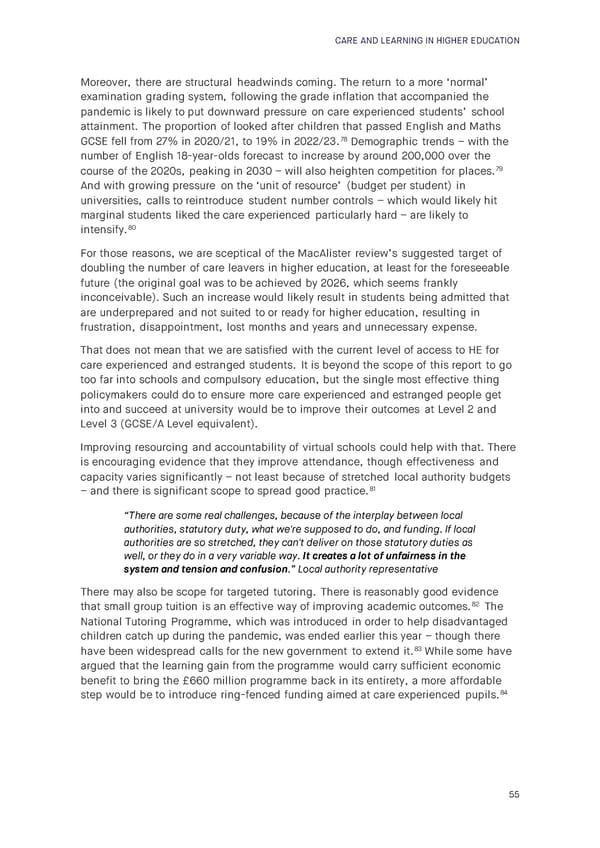CARE AND LEARNING IN HIGHER EDUCATION Moreover, there are structural headwinds coming. The return to a more ‘normal’ examination grading system, following the grade inflation that accompanied the pandemic is likely to put downward pressure on care experienced students’ school attainment. The proportion of looked after children that passed English and Maths GCSE fell from 27% in 2020/21, to 19% in 2022/23.78 Demographic trends – with the number of English 18-year-olds forecast to increase by around 200,000 over the course of the 2020s, peaking in 2030 – will also heighten competition for places.79 And with growing pressure on the ‘unit of resource’ (budget per student) in universities, calls to reintroduce student number controls – which would likely hit marginal students liked the care experienced particularly hard – are likely to intensify.80 For those reasons, we are sceptical of the MacAlister review’s suggested target of doubling the number of care leavers in higher education, at least for the foreseeable future (the original goal was to be achieved by 2026, which seems frankly inconceivable). Such an increase would likely result in students being admitted that are underprepared and not suited to or ready for higher education, resulting in frustration, disappointment, lost months and years and unnecessary expense. That does not mean that we are satisfied with the current level of access to HE for care experienced and estranged students. It is beyond the scope of this report to go too far into schools and compulsory education, but the single most effective thing policymakers could do to ensure more care experienced and estranged people get into and succeed at university would be to improve their outcomes at Level 2 and Level 3 (GCSE/A Level equivalent). Improving resourcing and accountability of virtual schools could help with that. There is encouraging evidence that they improve attendance, though effectiveness and capacity varies significantly – not least because of stretched local authority budgets – and there is significant scope to spread good practice.81 “There are some real challenges, because of the interplay between local authorities, statutory duty, what we're supposed to do, and funding. If local authorities are so stretched, they can't deliver on those statutory duties as well, or they do in a very variable way. It creates a lot of unfairness in the system and tension and confusion.” Local authority representative There may also be scope for targeted tutoring. There is reasonably good evidence that small group tuition is an effective way of improving academic outcomes.82 The National Tutoring Programme, which was introduced in order to help disadvantaged children catch up during the pandemic, was ended earlier this year – though there 83 have been widespread calls for the new government to extend it. While some have argued that the learning gain from the programme would carry sufficient economic benefit to bring the £660 million programme back in its entirety, a more affordable step would be to introduce ring-fenced funding aimed at care experienced pupils.84 55
 Care and Learning in Higher Education Page 55 Page 57
Care and Learning in Higher Education Page 55 Page 57